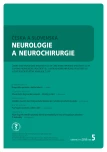Diagnostic in Patient with Acute Vertigo
Authors:
J. Jeřábek
Authors place of work:
Neurologická klinika 2. LF UK a FN v Motole
Published in the journal:
Cesk Slov Neurol N 2015; 78/111(5): 503-509
Category:
Minimonografie
doi:
https://doi.org/10.14735/amcsnn2015503
Summary
The following text summarizes management of patients with sudden vertigo. The main aim of the initial examination is to decide whether we are facing a patient with life-threatening disease, e.g. stroke, or a benign disease such as vestibular neuritis. This decision is usually made under a time pressure and knowing that neuroradiology examination may not provide sufficient information. Clinical examination of the vestibular and oculomotor function is sufficient to make the initial decision. Vestibular examination requires basic knowledge of the vestibular system function and reflex circuits involved in the organization and control of the multisensoric balance system.
Key words:
diziness – vertigo – instability – unsteadiness – head impulse test – vestibular system – stroke
The author declare he has no potential conflicts of interest concerning drugs, products, or services used in the study.
The Editorial Board declares that the manuscript met the ICMJE “uniform requirements” for biomedical papers.
Zdroje
1. Baloh RW. Dizziness in older people. J Am Geriatric Soc 1992; 40(7): 713– 721.
2. Halmagyi GM, Curthoys I. A clinical sign of canal paresis. Arch Neurol 1988; 45(7): 737– 739.
3. Longridge NS, Malinson AI. A dynamic illegible E‑ test. A technique for assessing vestibule‑ ocular reflex. Acta Otolaryngol 1987; 103: 273– 279. doi: 10.3109/ 000164 88709107794.
4. Brodsky MC, Donahue SP, Vaphiades M, Brandt T. Skew deviation revissited. Surv Ophthalmol 2006; 51(2): 105– 128.
5. Dix MR, Hallpike CS. The pathology, symptomatology and diagnosis of certain common disorders of vestibular system. Ann Otol Rhinol Laryngol 1952; 61(4): 987– 1016.
6. Ambler Z, Jeřábek J. Diferenciální diagnostika závratí. 2. vyd. Praha: Triton 2008.
7. Bronstein A, Lempert T. Dizziness A practical approach to diagnosis and management. Cambridge: University Press 2007.
8. Lempert T, Neuhauser H. Epidemiology of vertigo, migraine and vestibular migraine. J Neurol 2009; 256(3): 333– 338. doi: 10.1007/ s00415‑ 009‑ 0149‑ 2.
9. Newman‑ Toker DE, Kerber KA, Yu‑ Hsiang Hsieh, Pula JH, Omron R, Saber‑ Tehrani AS et al. HINTS outperforms ABCD2 to screen for stroke in acute continuous vertigo and dizzeness. Acad Emerg Med 2013; 20(10): 987– 996. doi: 10.1111/ acem.12223.
10. Navi BB, Kamel H, Shah MP, Grossman AW, Wong C, Poisson SN et al. Application of ABCD2 score to identify cerebrovascular causes of dizziness in the emergency department. Stroke 2012; 43(6): 1484– 1489. doi: 10.1161/ STROKEAHA.111.646414.
11. Newmann‑Toker DE, Saber Tehrani AS, Mantokoudis G, Pula JH, Guede CI, Kerber KA et al. Quantitative video‑ oculography to help diagnose stroke in acute vertigo and dizziness: towards an ECG for the eyes. Stroke 2013; 44(4): 1158– 1161. doi: 10.1161/ STROKEAHA.111.000033.
12. Brandt T, Detrich M, Strupp M. Vertigo and dizziness – common complaints. 2nd ed. London: Springer 2013.
13. Brandt T. Vertigo. Its multisensory syndromes. 2nd ed. New York: Springer 1999: 536.
Štítky
Detská neurológia Neurochirurgia NeurológiaČlánok vyšiel v časopise
Česká a slovenská neurologie a neurochirurgie

2015 Číslo 5
- Metamizol jako analgetikum první volby: kdy, pro koho, jak a proč?
- Fixní kombinace paracetamol/kodein nabízí synergické analgetické účinky
- Neuromultivit v terapii neuropatií, neuritid a neuralgií u dospělých pacientů
- Antidepresivní efekt kombinovaného analgetika tramadolu s paracetamolem
Najčítanejšie v tomto čísle
- Diagnostika pacienta s akutní závratí
- Recidivující tranzitorní globální amnézie – čtyři kazuistiky
- Normativní studie testu Reyovy‑ Osterriethovy komplexní figury v populaci českých seniorů
- Přínos vyšetření čichu pro diagnostiku neurodegenerativních onemocnění
